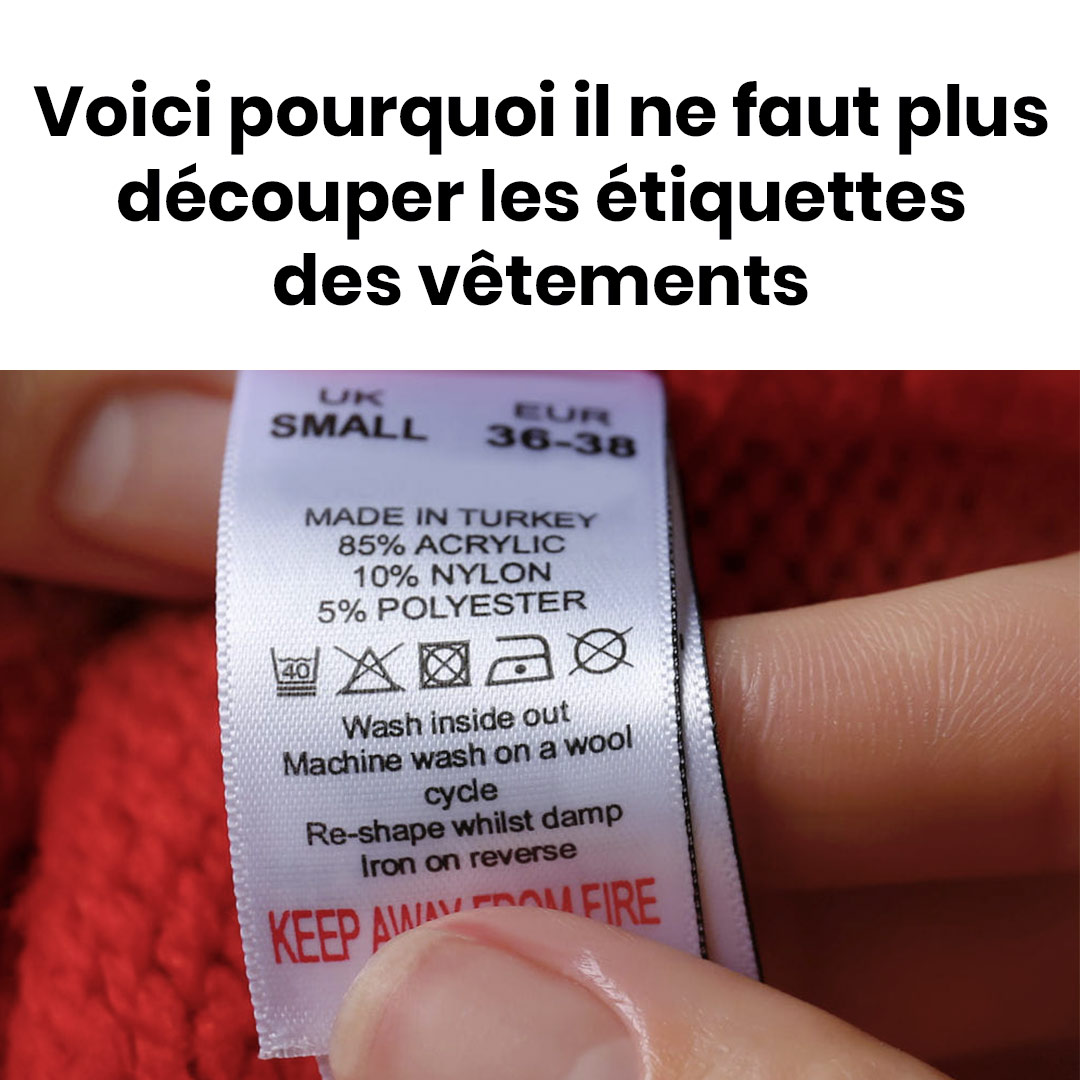Who has never experienced that small discomfort caused by a label scratching at the neck or side of a piece of clothing? The temptation to cut it off immediately for the sake of comfort is strong. However, these little pieces of fabric are not there by accident. By removing them, you may be losing essential information, and you could even compromise the longevity of your clothes. Let’s take a closer look at why it’s better to think twice before reaching for the scissors!
The Lesser-Known Reasons
The Label: A True Care Guide
Imagine purchasing a beautiful shirt or wool sweater without knowing the ideal washing temperature… The result? After a wash in water that’s too hot, your garment shrinks and becomes unwearable. The label contains all the necessary instructions to take care of your clothes: washing temperature, drying, ironing, and sometimes dry cleaning. By removing it, you risk damaging your clothes more quickly!
Tip: If the label bothers you, take a photo of it before cutting it off. This way, you’ll have a digital copy on hand whenever needed.
A Goldmine of Information on Fabric Composition
Silk, cotton, polyester, merino wool… Each textile has its own specifics. Some fabrics require delicate washing, while others are sensitive to exposure to sunlight or excessive heat. Cutting off the label means losing a valuable reference that can help you properly care for your clothes and avoid unpleasant surprises.
Practical Example: Wool and cashmere should be washed at low temperatures, ideally by hand. Without this information, you risk transforming your favorite sweater into a child-size garment after an overly aggressive wash!
An Ally Against Allergies
Some people are sensitive to certain textiles or chemicals used in the processing of clothing. Labels sometimes mention crucial information such as the presence of allergens (dyes, finishing agents, synthetic fibers). Without this information, it becomes more difficult to make choices that are suitable for your skin.
Practical Advice: If you have sensitive skin, choose clothes made from organic cotton or natural fibers, and always keep the label information before washing a new garment.
Impact on Resale and Donations
Do you plan to resell a piece of clothing or donate it to a charity? Keeping the label allows you to provide precise information about the brand, size, and care instructions. Buyers and charities prefer clothes with their original labels because it guarantees better identification of the product.
Keep in Mind: A cut label can lower the value of a garment when reselling it on platforms like Vinted or Le Bon Coin.
Legal Compliance
Clothing labels are not there by accident: they often serve legal requirements. They specify the country of manufacture, quality standards, and sometimes even labels guaranteeing ethical production conditions. By cutting them off, you erase important information.
Eco-responsibility: Certain labels, like GOTS (for organic cotton) or OEKO-TEX, guarantee that the product was made without harmful substances. Keeping the label ensures that you’re making an environmentally and health-conscious purchase.
How to Manage an Irritating Label Without Cutting It?
If the label truly bothers you, here are a few alternatives to avoid losing these valuable pieces of information:
- Fold it inward and sew it down with a few stitches.
- Use an iron to flatten it and avoid scratching.
- Cut it partially, leaving the part with the essential information.
- Digitize it: take a photo or write down the information before removing it.
By using these methods, you can still preserve the comfort and practical benefits of having the label without having to cut it off entirely.
In Conclusion: A Label Is Worth a Few Seconds of Discomfort!
Rather than seeing them as mere pieces of fabric that clutter your clothing, think of your labels as valuable guides to help prolong their lifespan, preserve their quality, and even protect your skin. Before cutting them off, carefully consider this: these small details can make a big difference!
And you, do you tend to keep or cut off your labels? Share your experiences in the comments!
The Importance of Garment Labels: A Closer Look
Garment labels often serve more than just a practical function. In fact, they can reveal crucial details about the item you’ve purchased. When you choose not to cut them off, you’re ensuring that you’re maximizing the value and longevity of your clothing. The importance of these small, often overlooked tags cannot be overstated.
A Key Source of Information for Sustainability
Sustainability has become a key concern for many consumers in recent years, and the information contained on clothing labels plays an essential role in this. Labels are often used to indicate whether garments are made from sustainably sourced materials or produced through ethical manufacturing practices. By removing labels, you’re not only losing valuable care instructions but also critical information about the environmental impact of your clothing. Labels such as “Fair Trade,” “Global Organic Textile Standard (GOTS),” or “Recycled Materials” are indicators that the garment is part of a responsible and eco-friendly fashion movement.
Understanding the Label: Beyond the Basics
A label is more than just a list of care instructions; it can tell you everything from the fabric’s origin to how the garment was processed. For example, knowing whether a garment is made from synthetic or natural fibers can affect your decision when it comes to washing it. Synthetics, such as polyester, may release microplastics when washed, while natural fibers like cotton, wool, and hemp are more biodegradable. Choosing eco-friendly fabrics is just one step toward a more sustainable wardrobe, but cutting off the label could prevent you from making the most environmentally conscious decisions in the future.
Clothing Labels and Consumer Rights
In addition to environmental considerations, the information on clothing labels also speaks to consumer rights. In many countries, manufacturers are legally required to include certain information on clothing labels. This includes the material composition, country of origin, and any applicable safety warnings regarding the garment. By removing the label, you’re not just taking away important care instructions, you’re potentially violating consumer protection laws by eliminating evidence of compliance. Keeping the label intact ensures that your rights as a consumer are respected, and it can help you address any issues that might arise with the item, should you need to return or exchange it.
The Role of Labels in Clothing Care and Maintenance
Garment labels also serve as a quick guide to understanding the level of care required to maintain your clothing in top condition. For example, items made from delicate fabrics such as silk or wool require gentler washing methods compared to more durable fabrics like cotton or polyester. Some garments may even be labeled with specific instructions on hand washing or dry cleaning, which could help preserve the fabric’s texture and color over time. Cutting off this valuable resource can lead to improper care, which in turn can cause irreversible damage to the garment.
Are There Any Exceptions?
While it is generally beneficial to keep clothing labels intact, there may be some exceptions to this rule. For instance, if you find the label is placed in an uncomfortable spot or irritates your skin, consider gently repositioning or securing it to prevent it from causing discomfort. If this still doesn’t alleviate the problem, cutting the label may be a last resort, but remember to keep a record of the care instructions in another way, such as photographing or noting them down.
For those who still prefer to cut the label out, just ensure that you’re not discarding essential details like the fabric composition, washing instructions, or legal information that could be useful in the future.
Final Thoughts
Whether for sustainability, health, comfort, or practicality, keeping clothing labels intact is often the best decision for maintaining the longevity of your clothes and making informed choices. Before cutting a label out, consider the benefits it provides and whether there’s another way to manage its discomfort. A few moments of minor irritation could save you from major wardrobe mishaps later on, and more importantly, help you make conscious decisions regarding your clothing’s care and the impact on the environment. So next time you’re tempted to grab those scissors, think twice – your wardrobe will thank you!




